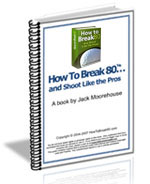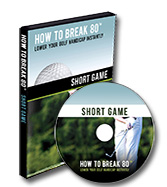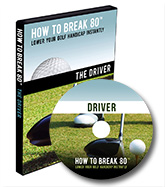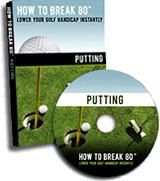|
===================================================
How To Break 80 Newsletter
February 7, 2007
"The Web's Most Popular Golf Improvement Newsletter"
===================================================
In this issue we'll discuss...
1) Swing Left for Softer Pitches
2) Quick Warm Up for Late Players
3) Question of the Week- Hitting out of Wet Sand
4) Article- Triggering Your Swing
5) Article- Five Things To Remember In Team Play
===================================================
1) Swing Left for Softer Pitches
===================================================
Getting the ball to stop on the green after a pitch shot is a challenge for most weekend golfers. Many have no problem generating sufficient loft to clear a greenside bunker or stream, but getting the ball to stop when it lands is a different matter. Usually, the ball hits and runs right off the green. If you're lucky, it lands in a patch of rough behind the hole. If you're not, it ends up in a greenside bunker.
Ideally, a pitch shot is played from 40-50 yards and in, with either a sand or a pitching wedge. The object is to hit the ball with enough loft to clear a bunker or other obstacle between you and the flag, and drop the ball softly on the green. A good pitch shot lands on the green, rolls a little, and stops close to the pin. Needless to say, a good pitch shot saves strokes.
Here are five tips for getting a pitch shot to stop softly on the green:
-Open stance/clubface
-Make upright swing
-Hold the club firmly with left hand (right-handers)
-Don't let the club's toe pass its heel
-Check your divots
To get the ball to land softly, you almost have to swing the club as if you were trying to slice the ball. This means in your follow through your hands will remain low and left (for right handers). Start by opening your stance and your clubface. Then take an upright swing on the downswing. At impact, hold firmly onto the club with your left hand right on through the follow-through. Don't let the club's toe pass its heel the way it would normally. This technique imparts sidespin on the ball at impact, causing the ball to land the way you want it to.
If you study several good pitchers, you'll probably see them use this technique to stop the ball faster on the green. Since this is somewhat of an advanced technique, you should try it only if you're pitching is acceptable and you've had a chance to practice the shot before hand. If you're pitching is needs work, you need to improve that before trying this technique.
Check your divots to make sure you're executing the shot correctly. They should be big and should point just to the left of the target. If they do, then chances are you're hitting the ball correctly. With time and practice, you'll gain better control of the shot and learn to stop the ball where you want it.
=================================================== 2)
Quick Warm Up for Late Players
===================================================
People are busier than ever. If they're not working in the office or doing repairs on their homes, they're dropping the kids off at somebody's house. It's not uncommon to find ourselves juggling several balls in the air while running from place to place. It's inevitable that sooner or later you'll be late for a golf match. So what do you do when you get to the course late?
Regardless of what time it is, you should warm up. You can't just step into the tee box and expect to play well without doing so before hand. Hitting balls is best, as we've mentioned in other golf tips, but if you're really late you obviously won't have time.
Here's a warm-up routine you can use instead.
-Take a middle iron, like a 5-iron or 6-iron, and grip it down to the steel so you can strike the ground when you swing. Stand way from your group and make slow non-stop mini swings. Do not allow your arms to go past hip height on the back swing or follow through all the way.
-When your arms and hands feel loose, graduate to longer, faster swings. Allow your arms to reach full height, back and through.
-Finally, make a series of full swings. Don't pause between them. Swing the club as fast as you can without losing your balance. You should feel everything moving smoothly. Keep swinging non-stop until you're out of breadth or break into a light sweat.
This warm-up routine is fast and easy. It takes about two minutes to complete, but it's worth it. It's not as good as hitting balls, but it's better than chipping balls to the nearest ball washer. Try it next time you find yourself running late for a match.
=================================================== 3)
Question of the Week- Hitting out of Wet Sand
===================================================
From Willy Serrrano
Hitting out of Wet Sand
Q. I do pretty well hitting to the green from greenside bunkers if the sand is dry, but I have never been able to get a decent shot from wet sand. It also seems that some traps have more mud than sand after a rain. HELP!
A. Thanks for the question, Van. There's one key difference in playing a bunker shot from wet sand than from dry. The clubface must be square at address, not open, even with a good lie. Once this change is made, the standard bunker shot procedure applies. Keep in mind that a bunker shot from wet sand is likely to come out on a slightly lower trajectory than normally. So allow for the change in trajectory.
And after a heavy rain when the sand has become hard-packed, try using a pitching wedge instead of a sand wedge. The pitching wedge's sharper leading edge cuts into the sand more effectively, creating as much of a splash affect as can be hoped for in wet sand. Also, you might consider taking a shorter, less aggressive swing with wet sand.
If your ball comes to rest in casual water within a bunker, you may take a drop without penalty at the nearest point of relief within the bunker, no nearer the hole. The rule applies no matter what the condition is of the rest of the bunker. On the other hand, a player may take a one-stroke penalty and drop outside the bunker. Whatever the conditions of the sand, if you hit from a bunker, make sure you rake it. It's common courtesy for other golfers.
If you've got a golf question you'd like answered, send an email to us at
questions@howtobreak80.com and we'll review it. I can't guarantee that we'll use it but if we do, we'll make sure to include your name and where you're from.
===================================================
If you want to truly discover the secrets of shooting like the Pros and creating a more reliable and consistent swing, check out:
http://www.HowToBreak80.com
P.S. Feel free to share this newsletter with family and friends. If you
would like to subscribe to this newsletter, send a blank email to
break80ezine@aweber.com
===================================================
About the Author
===================================================
Jack Moorehouse is the author of the best-selling book
"How To Break 80 and Shoot Like the Pros!". He is NOT a golf pro, rather a working man that has helped thousands of golfers from all seven continents lower their handicaps quickly. His free weekly newsletter goes out to thousands of golfers worldwide and provides the latest golf tips, strategies, techniques and instruction on how to improve your golf game.
|
Tools To
Help Your Game!

eBook

Physical Book

Audio Program

Short Game DVD

Driver DVD

|